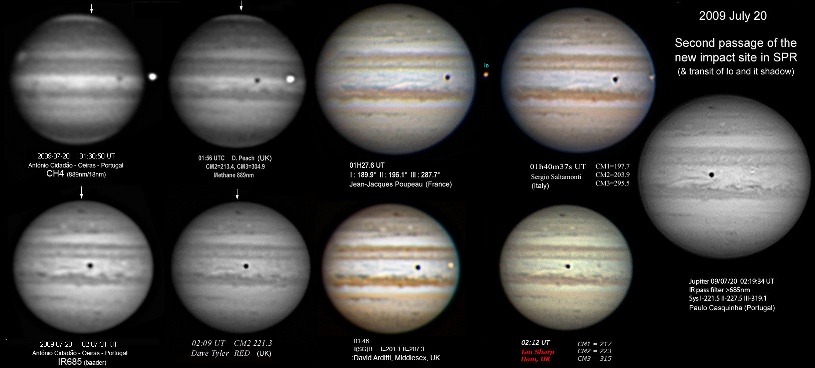
[3] A new impact appears on Jupiter. July 20th, 2009.
New impact site on Jupiter
Anthony Wesley in Australia has discovered a new impact site on Jupiter, in the
form of a virtually-black spot in the South Polar Region, just like one of the
SL9 impacts of 1994. It appeared on July 19. He reported it while still
observing it (in freezing temperatures) and sent the following message:
"Attached is my first image of a new dark spot that has appeared on
Jupiter.
Its in the SPR, and as you can see from the oblique angle of the dark spot in
the attached image it's clearly not a moon shadow. Looks like Jupiter has been
hit by something - how exciting!!!"
Link:
http://jupiter.samba.org/jupiter-impact.html
or
http://www.acquerra.com.au/astro/gallery/jupiter/
The dark spot is at L2 = 216, and latitude ~57 deg.S. T. Mishina
(Japan) also reported the same
spot in an image taken at about the same time.
The dark spot has a diffuse fringe on the NW side which no doubt represents the
ejecta arc, indicating that the impactor came from that direction. The
impact site resembles those of medium-sized SL9 impactors (fragments C, E, or
H), which became larger over the first few days and remained visible for several
weeks.
One rotation later, on July 20 around 02h UT, various European observers were
able to record the impact site, which had not changed much, as shown on the
attached image set. The impact site was slightly less dark in
near-infrared, as were the SL9 sites. Most importantly, A. Cidadao and D.
Peach both obtained methane-band images, which showed the impact site as a small
bright spot, as expected.
There is no doubt that this is an impact site like those of SL9 exactly 15 years
earlier, as many experienced observers have testified. There was no
feature at this site before; no such ultra-dark spot has ever been seen at such
high latitude; its extreme darkness and detailed shape closely resemble the SL9
scars (and no meteorological feature); and its brightness in methane indicates
that it is a high-altitude cloud of soot like those of SL9.
The last definite pre-impact image that we've seen is on July 18, 09:02 UT, by
David Kolb (Kansas) [Spaceweather.com]. The last probable pre-impact image
is on July 19, 07:40 UT, by Rich Jakiel (Georgia, USA) [ALPO]; however the
impact site would have been 61 deg. preceding the CM so it might have been
missed. Are there any others?? From the fresh appearance in
Anthony's images on July 19, ~16h UT, it was probably on its first or second
passage then.
See the 'Publications' page for references to our full reports on the SL9
impacts in the Journal of the BAA.
John Rogers & Damian Peach, 2009 July 20.